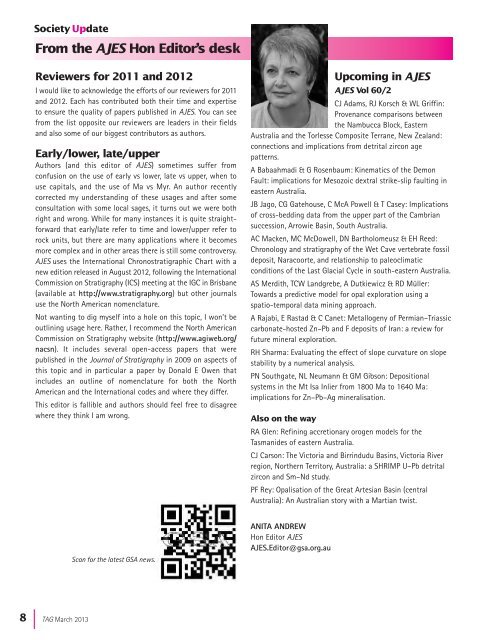TAG 166 - Geological Society of Australia
TAG 166 - Geological Society of Australia
TAG 166 - Geological Society of Australia
You also want an ePaper? Increase the reach of your titles
YUMPU automatically turns print PDFs into web optimized ePapers that Google loves.
<strong>Society</strong> UpdateFrom the AJES Hon Editor’s deskReviewers for 2011 and 2012I would like to acknowledge the efforts <strong>of</strong> our reviewers for 2011and 2012. Each has contributed both their time and expertiseto ensure the quality <strong>of</strong> papers published in AJES. You can seefrom the list opposite our reviewers are leaders in their fieldsand also some <strong>of</strong> our biggest contributors as authors.Early/lower, late/upperAuthors (and this editor <strong>of</strong> AJES) sometimes suffer fromconfusion on the use <strong>of</strong> early vs lower, late vs upper, when touse capitals, and the use <strong>of</strong> Ma vs Myr. An author recentlycorrected my understanding <strong>of</strong> these usages and after someconsultation with some local sages, it turns out we were bothright and wrong. While for many instances it is quite straightforwardthat early/late refer to time and lower/upper refer torock units, but there are many applications where it becomesmore complex and in other areas there is still some controversy.AJES uses the International Chronostratigraphic Chart with anew edition released in August 2012, following the InternationalCommission on Stratigraphy (ICS) meeting at the IGC in Brisbane(available at http://www.stratigraphy.org) but other journalsuse the North American nomenclature.Not wanting to dig myself into a hole on this topic, I won’t beoutlining usage here. Rather, I recommend the North AmericanCommission on Stratigraphy website (http://www.agiweb.org/nacsn). It includes several open-access papers that werepublished in the Journal <strong>of</strong> Stratigraphy in 2009 on aspects <strong>of</strong>this topic and in particular a paper by Donald E Owen thatincludes an outline <strong>of</strong> nomenclature for both the NorthAmerican and the International codes and where they differ.This editor is fallible and authors should feel free to disagreewhere they think I am wrong.Upcoming in AJESAJES Vol 60/2CJ Adams, RJ Korsch & WL Griffin:Provenance comparisons betweenthe Nambucca Block, Eastern<strong>Australia</strong> and the Torlesse Composite Terrane, New Zealand:connections and implications from detrital zircon agepatterns.A Babaahmadi & G Rosenbaum: Kinematics <strong>of</strong> the DemonFault: implications for Mesozoic dextral strike-slip faulting ineastern <strong>Australia</strong>.JB Jago, CG Gatehouse, C McA Powell & T Casey: Implications<strong>of</strong> cross-bedding data from the upper part <strong>of</strong> the Cambriansuccession, Arrowie Basin, South <strong>Australia</strong>.AC Macken, MC McDowell, DN Bartholomeusz & EH Reed:Chronology and stratigraphy <strong>of</strong> the Wet Cave vertebrate fossildeposit, Naracoorte, and relationship to paleoclimaticconditions <strong>of</strong> the Last Glacial Cycle in south-eastern <strong>Australia</strong>.AS Merdith, TCW Landgrebe, A Dutkiewicz & RD Müller:Towards a predictive model for opal exploration using aspatio-temporal data mining approach.A Rajabi, E Rastad & C Canet: Metallogeny <strong>of</strong> Permian–Triassiccarbonate-hosted Zn–Pb and F deposits <strong>of</strong> Iran: a review forfuture mineral exploration.RH Sharma: Evaluating the effect <strong>of</strong> slope curvature on slopestability by a numerical analysis.PN Southgate, NL Neumann & GM Gibson: Depositionalsystems in the Mt Isa Inlier from 1800 Ma to 1640 Ma:implications for Zn–Pb–Ag mineralisation.Also on the wayRA Glen: Refining accretionary orogen models for theTasmanides <strong>of</strong> eastern <strong>Australia</strong>.CJ Carson: The Victoria and Birrindudu Basins, Victoria Riverregion, Northern Territory, <strong>Australia</strong>: a SHRIMP U–Pb detritalzircon and Sm–Nd study.PF Rey: Opalisation <strong>of</strong> the Great Artesian Basin (central<strong>Australia</strong>): An <strong>Australia</strong>n story with a Martian twist.Scan for the latest GSA news.ANITA ANDREWHon Editor AJESAJES.Editor@gsa.org.au8 |<strong>TAG</strong> March 2013
















